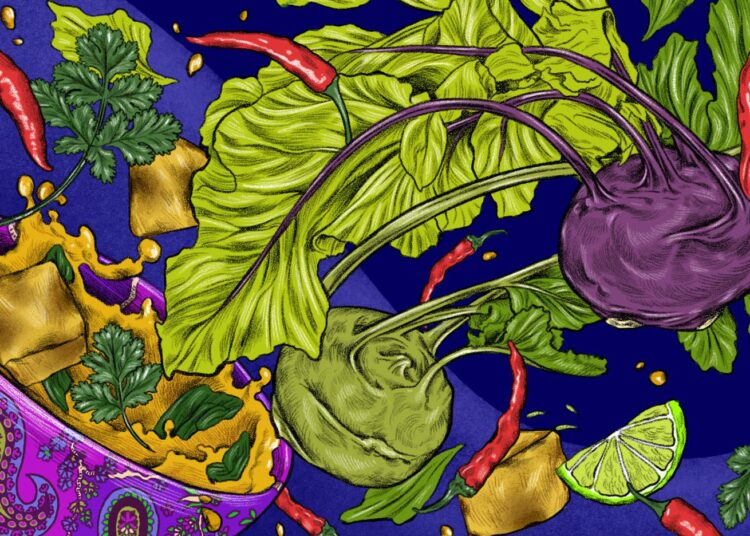Make kadam ka saag, a five-ingredient Kashmiri soup for the soul
In the 1978 Vegetable Book, credited with introducing Americans to lesser-known produce, the English cookbook author Jane Grigson gave kohlrabi a lackluster review. “There are better vegetables than kohlrabi,” she wrote. “And worse.” The 1999 edition of the Oxford Companion to Food wasn’t any more generous, describing the Sputnik-shaped cruciferous vegetable as a “bizarre form of the common cabbage.”
When I first moved to the U.S. from northern India, I couldn’t understand the American apathy towards kohlrabi. In Kashmir’s snow-capped mountains, the spiky green thrives, providing a welcome jolt of fresh flavor during the region’s long winters. But in the U.S. it mostly appeared in slaws or braises, if it appeared at all. Kohlrabi seemed doomed to a lifetime of unpopularity.
Fortunately, this meant more for me, and that I now had year-round opportunities to make kadam ka saag, a vegan delight traditionally limited to the coldest months in my hometown of Delhi. Kashmiri monjhe haakh, or kadam ka saag in the Hindi belt, translates to kohlrabi stewed greens, and it brings out the unsung vegetable’s true potential. Similar in theme to a hearty kimchi jiggae or English cabbage soup, kadam ka saag packs a punch with only a handful of ingredients, and is ready to serve in under 20 minutes.
The soup couldn’t be simpler to prepare: Start by peeling and chopping 2 large kohlrabi bulbs into 1-inch cubes, reserving the stems and leaves. Heat a large heavy-bottomed pot over high heat with a drizzle of neutral oil, then saute the chopped kohlrabi bulbs until they’re golden brown and aromatic, about 10 minutes. Toss in a teaspoon of cumin seeds, along with a teaspoon of powdered fennel seeds, the sleeper hit of this whole recipe. Fennel powder’s licorice-like notes are the perfect complement to kohlrabi’s warm, rooty sweetness.
I like to add 2 dried red chiles, though you can also use cayenne or red pepper flakes if that’s what you have on hand. Cook for a few minutes until everything is fragrant and sizzling, then lower the heat to medium-high, add salt to taste and 4 cups of chicken broth or water, and simmer for about ten minutes, until the kohlrabi is cooked through but not mushy.
Tear the reserved kohlrabi leaves into 3- or 4-inch strips, and drop them into the soup. They’ll quickly wilt into the broth, reminiscent of the wakame in miso soup. Some kadam ka saag recipes call for whisking a bit of yogurt and then stirring it in at the end (the whisking prevents it from splitting), but for me, a squeeze of lime adds that same pop of acidity without diluting the kohlrabi’s natural sweetness.
I like to garnish the soup with cilantro leaves, and serve it with rice or crusty bread. A smattering of chile crisp isn’t traditional, but is entirely welcome at my table, too. My family often serves the dish with a sidecar of pan-fried paneer or halloumi, or garlic chips if we have them on hand.
Whether I’m facing homesickness, heartbreak, or just a hangover, this soup has been my savior more times than I can count. Kohlrabi has been overlooked for too long. This recipe finally puts the oddball vegetable right where it belongs: front and center, as the rightful star of the show.
Mehr Singh is a food and culture reporter based in New York. Her work appears in Bon Appétit, Food52, MR Magazine, and other publications.
Dilek Baykara is a Turkish-American illustrator, print designer, and adventurous gastronome living in Brooklyn, New York.














